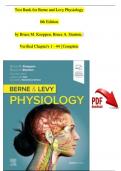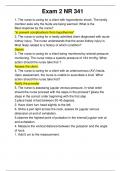Test Bank for Berne and Levy Physiology
8th Edition
by Bruce M. Koeppen, Bruce A. Stanton, |
Verified Chapter's 1 - 44 | Complete
,TABLE OF CONTENTS
Section 1: Cellular Physiology
1 Principles of Cell and Membrane Function
2 Homeostasis: Volume and Composition of Body Fluid Compartments
3 Signal Transduction, Membrane Receptors, Second Messengers, and
Regulation of Gene Expression
Section 2: Neurophysiology
4 The Nervous System: Introduction to Cells and Systems
5 Generation and Conduction of Action Potentials
6 Synaptic Transmission
7 The Somatosensory System
8 The Special Senses
9 Organization of Motor Function
10 Integrative Functions of the Nervous System
11 The Autonomic Nervous System and Its Central Control
Section 3: Muscle Physiology
12 Skeletal Muscle Physiology
13 Cardiac Muscle
14 Smooth Muscle
Section 4: Cardiovascular Physiology
15 Overview of Circulation
16 Elements of Cardiac Function
17 Properties of the Vasculature
,18 Regulation of the Heart and Vasculature
19 Integrated Control of the Cardiovascular System
Section 5: Respiratory Physiology
20 Introduction to the Respiratory System
21 Static Lung and Chest Wall Mechanics
22 Dynamic Lung and Chest Wall Mechanics
23 Ventilation, Perfusion, and Ventilation/Perfusion Relationships
24 Oxygen and Carbon Dioxide Transport
25 Control of Respiration
26 Host Defense and Metabolism in the Lung
Section 6: Gastrointestinal Physiology
27 Functional Anatomy and General Principles of Regulation in the
Gastrointestinal Tract
28 The Cephalic, Oral, and Esophageal Phases of the Integrated Response to a
Meal
29 The Gastric Phase of the Integrated Response to a Meal
30 The Small Intestinal Phase of the Integrated Response to a Meal
31 The Colonic Phase of the Integrated Response to a Meal
32 Transport and Metabolic Functions of the Liver
Section 7: Renal Physiology
33 Elements of Renal Function
34 Solute and Water Transport Along the Nephron: Tubular Function
35 Control of Body Fluid Osmolality and Volume
36 Potassium, Calcium, and Phosphate Homeostasis
37 Role of the Kidneys in the Regulation of Acid-Base Balance
,Section 8: Endocrine Physiology
38 Introduction to the Endocrine System
39 Hormonal Regulation of Energy Metabolism
40 Hormonal Regulation of Calcium and Phosphate Metabolism
41 The Hypothalamus and Pituitary Gland
42 The Thyroid Gland
43 The Adrenal Gland
44 The Male and Female Reproductive Systems
, Koeppen: Berne and Levy Physiology, 8th Edition
Chapter 01: Principles of Cell
Function Test Bank
Multiple Choice
1. The subcellular structure that degrades proteins is called the:
A. Tight junction
B. Mitochondria
C. Lysosome
D. Plasma membrane
E. Ribosome
ANS: C
2. An experiment is done to measure the uptake of an amino acid into a cell. The following
data are obtained:
N
If Na+ is removed from the extracellular bathing solution, or if a drug is added that prevents the
cell from making adenosine triphosphate (ATP), the uptake of amino acid into the cell is
markedly reduced. According to this information, which of the followingmechanisms is
probably responsible for the transport of the amino acid into the cell?
A. Passive diffusion through the lipid bilayer
B. Uniporter
C. Transport ATPase
D. Na+ symporter
E. Na+ antiporter
ANS: D
3. A membrane permeable by only Na+ separates two compartments containing
Na2SO4,shown as follows:
,Electrodes are placed in both compartments, and a voltage is applied (that of compartment A is
held at 0 mV). What voltage applied to compartment B would result in no net movement of Na+
across the membrane separating the compartments?
A. –60 mV
B. –30 mV
C. 0 mV
D. +30 mV
E. +60 mV
ANS: E
The rest ing membrane potentN cell is –85.C
ial oRf a I
S NG B
4. mV. The intracellular and extracellular
U indicated
concentrations of several ions are in the following table, as is the calculated
Nernst equilibrium potential (Ei) for each of these ions:
Ion Concentration Concentration Ei
Inside Cell Outside Cell
Na+ 12 mEq/L 145 mEq/L 66 mV
K+ 150 mEq/L 4 mEq/L –96 mV
Cl– 30 mEq/L 105 mEq/L –33 mV
Ca++ 0.0001 mmol/dL 1 mmol/dL 122 mV
The membrane has channels for Na+, K+, Cl–, and Ca++. The conductance of the
membrane is the greatest for which ion?
A. Na+
B. K+
C. Cl–
D. Ca++
ANS: B
5. A cell contains the following membrane transporters:
Na+ channelK+ channel
Na+,K+-ATPase
The resting membrane voltage of the cell is –80 mV, and the intracellular and
,extracellular ion concentrations are as follows:
Ion Intracellular Extracellular
Concentration Concentration
Na+ 10 mEq/L 145 mEq/L
K+ 120 mEq/L 4 mEq/L
The cell is treated with a drug to inhibit the Na+,K+-ATPase. What would be the effect ofthis drug
on the following parameters?
Intracellular [Na+] Intracellular [K+] Cell Volume Membrane Voltage
A. Decrease Decrease Decrease Depolarize
B. Increase Decrease Increase Depolarize
C. Increase Increase Increase No change
D. Decrease Increase Decrease Hyperpolarize
E. Increase Increase Decrease Hyperpolarize
ANS: B
6. Which of the labeled proteins (shaded) is attached to the membrane by a
glycosylphosphatidylinositol (GPI) anchor?
ANS: E
7. A cell has channels for Na+, K+, and Cl– in its plasma membrane. The resting membrane
potential is –60 mV (cell interior negative). The intracellular and extracellular
concentrations for these ions, as well as the calculated Nernst potentials, are listed as
follows:
, Ion Intracellular Extracellular Ei
Concentration Concentration
Na+ 14 mEq/L 140 mEq/L 60 mV
K+ 150 mEq/L 5 mEq/L –89 mV
Cl– 10 mEq/L 100 mEq/L –60 mV
A drug is applied to the cell that increases the permeability of the cell by Cl– (i.e., it opens Cl–
channels). What effect will this drug have on the net movement of Cl– acrossthe plasma
membrane?
A. Net Cl– movement out of the cell will be increased.
B. Net Cl– movement into the cell will be increased.
C. There will be no change in the net movement of Cl–.
ANS: C
8. Reducing the extracellular [K+] would be expected to have which of the following
effects on the resting membrane potential and on the excitability of ventricular
myocytes?
Membrane Potential Excitability
A. Unchanged Unchanged
B. Hyperpolarized GDT
ecBre.aC
seO
d
C. Hyperpolarized Increased
D. Depolarized Decreased
E. Depolarized Increased
ANS: B
9. A cell is bathed in an isotonic NaCl solution that contains 5 mmol/L of glucose. The
intracellular concentration of glucose is 10 mmol/L. What is the most likely mechanism
for the transport of glucose across the plasma membrane into this cell?
A. Glucose uniporter
B. Na+-glucose symporter
C. Na+-glucose antiporter
D. Diffusion of glucose through the lipid bilayer of the membrane
ANS: B
10. A blood sample is taken from an individual whose blood osmolality is 295 mOsm per
kilogram of water. Red blood cells from this sample are then placed in the following
solutions:
, 1-5
Solution Osmolality (mOsm/kg H2O) Reflection
Coefficient
( of
Solute
1. NaCl 300 1
2. Fructose 300 0.5
3. Urea 300 0
4. CaCl2 100 1
5. KCl 150 1
The red blood cells in which of these solutions will swell to the greatest degree?
A. 1
B. 2
C. 3
D. 4
E. 5 ANS:
C
11. A solution that causes a cell to shrink is:
A. Isotonic
B. Hypotonic
C. Hypertonic
ANS: C
12. Osmosis is:
A. The active transport of water
B. The number of solute particles in 1 kg of water
C. The diffusion of water across cell membranes
D. The defined as the weight of a volume of a solution divided by the weight of an
equivalent volume of distilled water
E. The amount of a substance relative to its molecular weight
ANS: C
, Koeppen: Berne and Levy Physiology, 8th Edition
Chapter 02: Homeostasis of Body
FluidsTest Bank
Multiple Choice
1.
A 100 mmol/L solution of MgCl2 would be expected to have an osmolality of which
ofthe following?
A. 50 mOsm/kg H2O
B. 100 mOsm/kg H2O
C. 200 mOsm/kg H2O
D. 300 mOsm/kg H2O
E. 350 mOsm/kg H2O
ANS: D
2.
Three individuals, each weighing 55 kg and each having a plasma [Na+] of 145 mEq/L,
receive infusions of different solutions. Individual A receives 1 L of isotonic NaCl (290
mOsm/kg H2O); individual BNrU ecR
eiSveIsN1GLToB
f a. CanM
mO nitol solut ion (290 mOsm/kg H2O); and
individual C receives 1 L of a 5% dextrose in water (D5W) solution (290 mOsm/kg
H2O). Assuming that there is no urine output, and after complete equilibration of the
extracellular and intracellular fluid, which of these individuals will have a lower plasma[Na+]?
A. Individual A (NaCl infusion).
B. Individual B (mannitol infusion).
C. Individual C (D5W infusion).
D. Individuals A, B, and C will have the same plasma [Na+].
ANS: B
3.
Intravenous infusion of 2 L of which of the following solutions will lead to the largest
increase in intracellular fluid volume?
A. D5W
B. Isotonic NaCl
C. Hypotonic NaCl
D. Hypertonic NaCl






